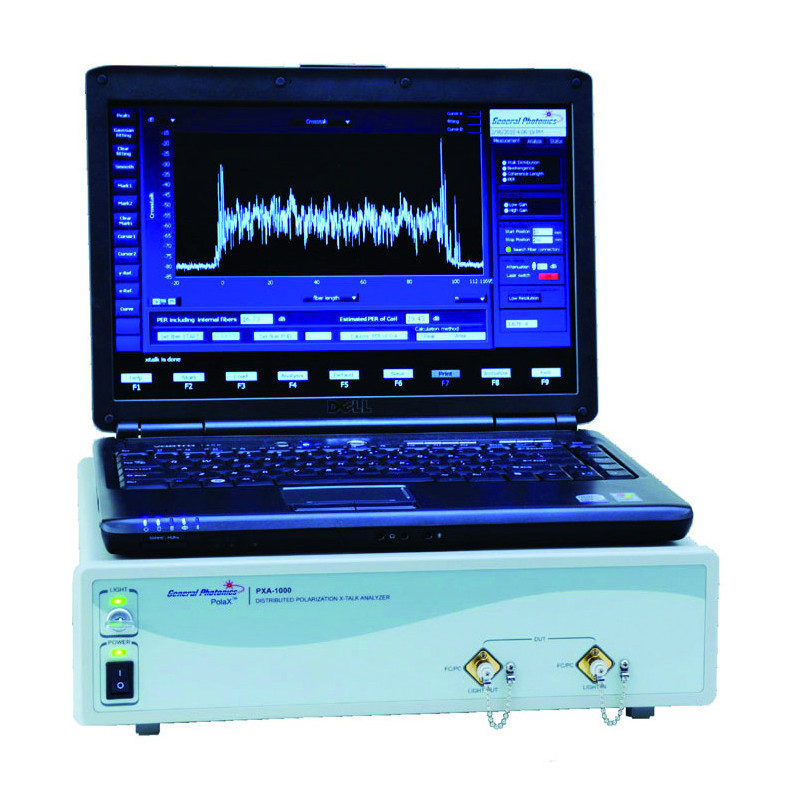Description
Distributed Polarization Crosstalk from General Photonics
The PXA-1000 Distributed Polarization Crosstalk (X-Talk) Analyzer is an enhanced white light interferometer that measures space-resolved stress by analyzing stress-induced polarization cross-coupling along a length of polarization maintaining (PM) fiber. The patented design eliminates strong zero-order interference and reduces the multi-coupling interference common in traditional white light interferometers, both of which can cause ?ghost? peaks in the measured signal. The removal of the ?ghost? peaks enables the PXA-1000 to unambiguously identify the magnitudes and locations of actual x-talk peaks, resulting in higher measurement sensitivity, higher dynamic range, and higher spatial measurement accuracy.
It locates imperfections or areas of local stress inside PM fiber coils including any stress from the winding process. The instrument can also completely characterize PM fiber (refer to the Application Note).
The PXA-1000 Distributed Polarization Crosstalk comes with a notebook computer and PolaXView? software.
Features of the Distributed Polarization Crosstalk
- High spatial resolution: 6 cm
- -75 dB polarization X-talk sensitivity
- 30 dB PER measurement range
- Large fiber measurement range: 2.6 km
Applications of the Distributed Polarization Crosstalk
- Qualification of PM fiber coils
- Measuring the extremely high PER of a polarizing waveguide
- Obtaining the autocorrelation function of a light source
- Measuring the birefringence of a PM fiber and the lengths of PM and SM fibers
Specifications of the Distributed Polarization Crosstalk
- Wavelength1: 1310 or 1550 nm
- Polarization X-talk Measurement Sensitivity: -75 dB (for DUT output power >5dBm. -80 dB typical)
- Polarization X-talk Measurement Noise Floor2: -95 dB
- Polarization X-talk Resolution: 0.25 dB
- Polarization X-talk Repeatability3: ±0.5 dB
- Polarization X-talk Accuracy4: ±0.5 dB
- Measurement or Sensing Range5 1.3 km or 2.6 km standard (3.1 km optional)
- Measurement Speed5,6: 8 s/100m
- Spatial Resolution7: 6 cm (Assuming no fiber dispersion, ?n = 5 × 10-4)
- PER Measurement Range: > 30 dB
- Spatial Accuracy5,8: ±20 cm
- Waveguide Polarization Dependent Attenuation: Up to 75dB (DUT output > 5dBm )
- LiNbO3 Waveguide Spatial Resolution: 0.75 mm
- SLD Power: > 10 dBm
- SLD Bandwidth: > 30 nm
- SLD PER: > 20 dB
- Software: PolaXView? (included)
- Operating Temperature: 10 to 50 °C
- Storage Temperature: -20 to 60 °C
- Power Supply: 100 ? 240 VAC, 50 ? 60 Hz
- Communications Interface: USB 2.0
- Display: Notebook computer with USB connection
- Dimensions: 2U, ¾ 19" rack width, 3.5" (H) x 14" (W) x 14?(D)
Notes:
1 Shorter wavelengths on request.
2 Defined as the system noise displayed on the polarization X-talk curve when input light is turned off during a measurement for which the DUT output power is >5 dBm.
3 Standard deviation of 20 successive measurements of the amplitude of a X-talk peak between -15 and -40dB.
4 At 23 ± 5 °C
5 Assuming PM fiber ?n of 5 × 10-4.
6 Average for full length test.
7 Defined as the minimum resolvable distance between two polarization X-talk points of equal amplitude, based on Sparrow Criterion (two peaks of equal height overlap at 3dB point, resulting in a flat-top curve) and measured when the peaks are between -15 and -40 dB.
8 Defined as the standard deviation of twenty successive measurements of the distance of an X-talk peak of height between -15 and -40 dB from the X-talk peak induced by the input connector (zero position).


